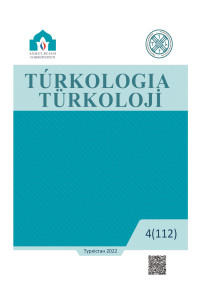THE PERCEPTUAL ETYMOLOGY AND THE ORIGIN OF THE OLD TURKİC ‘ÏMGA’ AND ‘IL ÏMGA’ VIA THE NEW THOUGHTS
Keywords:
Old Turkic, Chinese, Khotanese, administrative-military titles, perceptual etymologyAbstract
When it comes to etymology, two methods come to mind: 1. Scientific or linguistic etymology and 2. Folk etymology. However, the Polish linguist Marek Stachowski introduced a new etymology term to the literature: 3.”Perceptual etymology”. Stachowski explains the term, which he coined for the first time in his article titled “Perceptual etymology, or three Turkish culinary terms in Croatian and Slovene, and a Polish social term inteligencja ‘intelligentsia’” published in Studia Linguistica Universitatis Iagellonicae Cracoviensis 138 (4) in 2021, in his article titled “Perceptual etymology. A social aspect of etymological research” published in issue 139 (1) of the same journal in 2022. In this study; unaware of this new term, the origin information of which is explained, 'اِمْغا', 'اَلِمْغا' in the Diwanu Lugati’t-Turk of Kashgari (Barskani) Mahmud and the titles ‘amγa’, ‘il ïmγa’ in Old Uighur letter documents, which mean “guard of the military governor, secretary of state”, which have meanings such as “state treasurer, treasurer, tax collector”, are reconsidered in the context of the concept of “perceptual etymology”. Based on the previous sources, it is accepted that the word was borrowed from a Chinese title, yaya (押牙 / 押衙), from a Middle Chinese pronunciation of *im go dar to Turkish during the Chinese Tang Dynasty. This title is represented by Sir G. Clauson ‘ımğa’, T. Takata ‘ąmäga’, N. Sims-Williams and J. Hamilton ’’mγ’ (amγa) and T. Moriyasu as amγa / ïmγa. Here, the origin information of the title in question will be tried to be explained again through their spellings, historical developments and meanings in old Uighur documents and to be shown that the title is not borrowed into Turkish from Chinese, but from Khotanese Sakan.
References
Stachowski, M. (2022). Perceptual etymology. A social aspect of etymological research. Studia Linguistica Universitatis Iagellonicae Cracoviensis,139 (1): 61-67.
Stachowski, M. (2021). Perceptual etymology, or three Turkish culinary terms in Croatian and Slovene, and a Polish social term inteligencja ‘intelligentsia’. Studia Linguistica Universitatis Iagellonicae Cracoviensis,138 (4): 221-225.
Liberman, A. (2005). Word origins… and how we know them. Oxford: Oxford University Press.
Stachowski, K. (2017). An experiment in labelling Draw-a-Map maps. Studies in Polish Linguistics 12 (4): 221–240.
Stachowski, K. (2018). Przyczynek do dialektologii percepcyjnej Polski: Szczecin. Język Polski 98 (1): 5–17.
Donuk, A. (1988). Eski Türk devletlerinde idarî-askerî unvan ve terimler. İstanbul: TDAV.
Kilisli Rifat [Bilge] (Haz.) (1333-1335). Kâşgarlı Mahmud, Kitâb-ı Dîvânu Lugâti’t-Türk, I-III. İstanbul.
Dankoff, R. ve Kelly, J. (1982). Maḥmūd el-Kāšγarī, Compendium of the Turkic Dialects (Dīwān Luγāt at-Turk), Part I, Sources of Oriental Languages and Literatures, Turkish Sources:7. Harvard University.
Ercilasun, A. B. ve Z. Akkoyunlu. (Haz.) (2015). Kâşgarlı Mahmud Dîvânu Lugâti’t-Türk, giriş-metin-çeviri-notlar-dizin (2. bs.). Ankara: Türk Dil Kurumu Yayınları.
Arat, R. R. (1947). Kutadgu Bilig, I Metin. İstanbul: Millî Eğitim Basımevi.
Kaçalin, M. S. (Haz.) (2008).Yûsuf Has Hâcib: Kutadğu Bilig, Metin. Kültür ve Turizm Bak. Yayınları (e-kitap). https://ekitap.ktb.gov.tr/TR-78447/yusuf-has-hacib---kutadgu-bilig.html (Erişim tarihi: 09.06.2022).
Arat, R. R. (1959). Kutadgu Bilig, II Tercüme. Ankara: TTK Basımevi.
Clauson, Sir G. (1972). An Etymological Dictionary of Pre-Thirteenth-Century Turkish. Oxford: Clarendon Press.
Sims-Williams, N. ve Hamilton, J. (1990). Documents turco-sogdiens du IXe -Xe siècle de Touen-houang. London: School of Oriental and African Studies.
Takata, T. (1987). Ąmäga. Studies in the vocabulary of Khotanese II. (R. E. Emmerick ve P. O. Skjærvø). Wien: Der Österreichischen Akademie der Wissenschaften, 17-18.
Mathews, R. H. (1972). Chinese-English Dictionary. Revised American Edition. (Twelfth Printing). Cambridge/Massachusetts: Harvard University Press.
Skaff, J. K. (2012). Sui-Tang China and its Turko-Mongol neighbors. Culture, power, and connections, 580-800. New York: Oxford University Press.
Ouyang, X. (2004). Historical records of the five dynasties. (Çev.) R. L. Davis. New York: Columbia University Press.
Wilkens, J. (2021). Handwörterbuch des Altuigurischen Altuigurisch – Deutsch – Türkisch. Göttingen: Universitätsverlag Göttingen.
Moriyasu, T. (2019). Corpus of the Old Uighur letters from the Eastern Silk Road. Berliner Turfantexte XLVI. Turnhout: Brepols Publishers.
Arslan, H. Ç. (2021). Eski Uygur mektuplarının incelenmesi ve söz varlığının Hakasça ile karşılaştırılması. Çukurova Üniversitesi Sosyal Bilimler Enstitüsü. Yayımlanmamış Doktora Tezi. Adana.
Turfanforschung Digitales Turfan-Archiv (2022). [2005]. Berlin-Brandenburgischen Akademie der Wissenschaften in der Staatsbibliothek zu Berlin-Preussischer Kulturbesitz Orientabteilung. Berlin:
http://turfan.bbaw.de/dta/u/dta_u_ index.htm. (Erişim tarihi: 11.06.2022).
Clauson, Sir G. (1973). Turkish philology in Hungary. = Review of L. Ligeti (ed.), Studia Turcica, Budapest 1971. Asia Major, NS. 18, 209-219.
Clark, L. V. (1977). Mongol elements in Old Turkic? Journal de la Société Finno-Ougrienne 75: 110-168.
Moriyasu, T. (1991). ウイグル=マニ教史の研究 Uiguru Manikyō-shi no kenkyū [A Study on the History of Uighur Manichaeism]. Ōsaka daigaku bungakubu kiyō [Memoirs of the Faculty of Letters Osaka University] 31/32.
Moriyasu, T. (2004). Die Geschichte des uigurischen Manichäismus an der Seidenstrasse: Forschungen zu manichäischen Quellen und ihrem geschichtlichen Hintergrund. Band 50 der Studies in Oriental religions. Wiesbaden: Otto Harrassowitz Verlag.
Hamilton, J. R. (2004). Remarks concerning Turfan stake inscription III. In Turfan Revisited - The first century of research into the arts and cultures of the Silk Road. (Eds.) D. Durkin-Meisterernst et al. Berlin: Dietrich Reimer Verlag, 121–124.
Moriyasu, T. (2015). Tōzai Uiguru to Cyūō Yūrasia 東西ウイグルと中央ユ ーラシア [East- and West-Uighurs in the Central Eurasia]. Nagoya: The University of Nagoya Press.
Aydın, E. (2009). Köl Tigin ve Bilge Kağan Yazıtlarındaki Amga (Amgı) Korgan Üzerine. Turkish Studies, Vol. 4/3 (Spring): 273-282.
Malov, S. Ye. (1951). Pamyatniki Drevnetyurkskoy Pis’mennosti. Moskva-Leningrad: İzdatel’stvo Akademiya NAUK SSSR.
Nadelyayev, V. M., vd. (1969). Drevnetyurkskiy slovar’. Leningrad: Akademiya Nauk SSSR.

